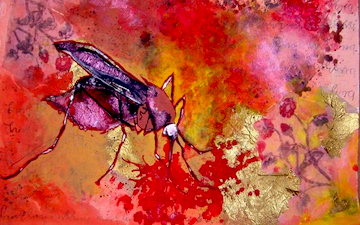Mosquito (from the Spanish or Portugueseword for little fly)[2][3][4][5] is a common insectin the family Culicidae (from the Latin culexmeaning midge or gnat).[6] Mosquitoes resemble crane flies (family Tipulidae) andchironomid flies (family Chironomidae), with which they are sometimes confused by the casual observer.
Mosquitoes go through four stages in their life-cycle: egg, larva, pupa, and adult or imago. Adult females lay their eggs in standing water, which can be a salt-marsh, a lake, a puddle, a natural reservoir on a plant, or an artificial water container such as a plastic bucket. The first three stages are aquatic and last 5–14 days, depending on the species and the ambient temperature; eggs hatch to become larvae, then pupae. The adult mosquito emerges from the pupa as it floats at the water surface. Adults live for 4–8 weeks.[7]
Mosquitoes have mouthparts that are adapted for piercing the skin of plants and animals. While males typically feed on nectar and plant juices, the female needs to obtain nutrients from a “blood meal” before she can produce eggs.
Both male and female mosquitoes are nectar feeders, but the females of many species are also capable of drinking blood from many mammals. Females do not require blood for their own survival, but they do need supplemental substances such as protein and iron to develop eggs.
Prior to and during blood feeding, they inject saliva into the bodies of their source(s) of blood. This saliva serves as an anticoagulant: without it, the female mosquito’s proboscis would quickly become clogged with blood clots. Female mosquitoes hunt their blood host by detectingcarbon dioxide (CO2) and 1-octen-3-ol from a distance.
(From Wikipedia, January 7th, 2011)
—
Adult mosquitoes occasionally obtain nectar at flowers, but they are not significant pollinators in temperate climates. Their larvae breed in water, while the females require a blood-meal from warm-blooded animals in order to lay numerous eggs. Mosquitoes can transmit numerous diseases to humans.
The antennae of male mosquitoes help them find female mosquitoes by sensing the frequency of their wingbeats with fine, hair-like structures.
(From Insect Visitors of Illinois Wildflowers , January 7th, 2011)
—




